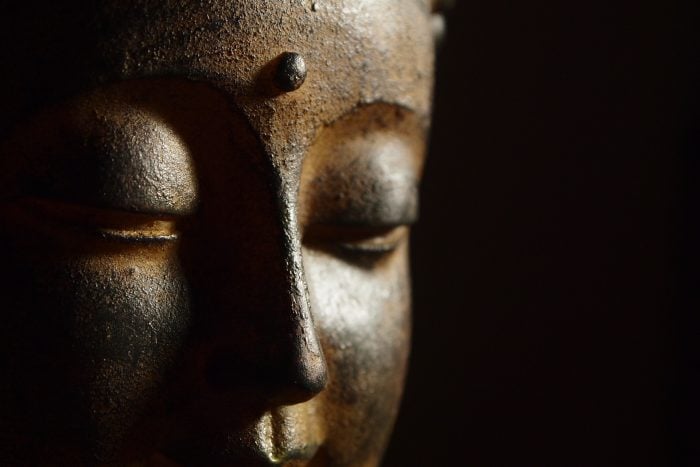
Under the Bodhi tree, the Buddha resolved not to leave his meditation seat until he was free.
His resolve had never been stronger and his goal had never been closer…and this brought about his greatest challenge.
On the eve of his auspicious achievement, the Buddha met his strongest obstacle: the tempting demon Mara. Mara arrived and attempted to distract the Buddha with harmful emotions, psychological trappings, and doubt-inducing disbelief in the Buddha’s goal.
Fortunately for us, we know the Buddha did not lose his resolve, and found his solution to suffering, which has now been passed on for millennia.
If we take only the slightest liberty in interpretation, we can see these final obstacles as the last, and therefore strongest, bits of suffering to exist in the Buddha’s own mind. Mara was at his most vengeful when Buddha was at his most inspired. Viewing Mara’s final temptation through this lens provides for an interesting reflection: why would Buddha’s most difficult hurdle come when he was closest to the finish line?
Coupling Dynamics as Trauma Boosters
I am a long-time meditator, Buddhism hobbyist, and somatic psychotherapist. In these pursuits, I have stumbled upon an interesting parallel to this mystery of the Buddha’s greatest mental obstacles. It concerns a pattern, seen in body-based forms of trauma resolution (such as Somatic Experiencing [SE]), known as coupling dynamics.
Coupling dynamics refers to the relationships in our minds between two or more things, which can often, due to trauma, be over- or under-associated. A classic example is the war veteran who panics when hearing fireworks because the sound of explosions is coupled with memories of a threatening attack. This is an example of two phenomena being over-coupled: an association is there that should not be. Things can also be under-coupled—when there should be an association where there is none—as is often the case when people show little affect in their relationships because they grew up in an emotionally cold home.
Personally, when I get angry, my solar plexus muscles tighten dramatically. It can be said that my anger has become coupled with abdominal muscle constriction. Ideally, this should not happen—instead, anger should come, be put to use, and then diminish. But in my case, anger happens, my gut clenches, sending somatic nerve messages to my brain that I am stuck in my anger, which facilitates greater anger, and the cycle compounds.
The Autonomic Nervous System and Spiritual Experience
So why does coupling like this happen? And why is it relevant to experiences of spiritual expansion, like the ones the Buddha went through?
To start, it’s important to remember that the Buddha had a nervous system, just like you and me. And all of our nervous systems (don’t you feel closer to the Buddha already?) have limitations on how much arousal they can sustain. Dr. Dan Siegel coined the term window of tolerance to represent the range of nervous system arousal each of us can sustain before some autonomic reaction occurs to limit our experience.
My stomach clenching can be seen as a response to trap arousal in the gut and stifle unpleasant symptoms—both psychological and physiological—that come with anger. How we learn these insulating behaviors is complex, varied, and beyond the scope of this article. For now, suffice it to say that as our nervous system arousal levels increase, we often find a protective (but challenging) symptom coupled with that level of arousal.
And here it is important to remember that levels of arousal in our nervous systems increase not just when things are challenging or threatening, but also when life circumstances are expansive, nurturing, or blissful. Even fortunate moments can bring increased heart rate, rapid blood flow to the now-tense muscles, and decreases in critical thinking.
Think back to the last time you met that new-and-sexy someone and how your heart rate increased drastically, while your rational faculties rapidly decreased. Or recall the moment you stood in front of an audience to perform or speak about something you love. Something as simple as severely good news can prompt unmanageably high levels of energy in our nervous system.
As a therapist, I have seen that long-term clients show up to the occasional session with nothing immediately distressing to work on because their life is going swimmingly and they are feeling well. Often, they are surprised when I ask them to tell me about the good feelings and fortunes being bestowed upon them—therapy is not supposed to be enjoyable! Eventually, they give in and share. But as they apply mindful awareness and begin to deeply feel the pleasant emotions and sensations associated with these blessings, something odd happens: something unpleasant emerges.
A client once told me about a new job she landed after longing for it for many months. As she became aware of the pleasant bodily response to this achievement, it shifted quickly to an emotional place of lack and she was barraged by memories of her father’s verbal abuse and belittling. The level of arousal in her nervous system had reached what a colleague of mine referred to as her upper limit—the maximum amount of pleasant experience we can handle before the arousal triggers challenging psychological material. She had expanded into joy and accomplishment and up popped a Mara.
Expansion and Contraction
In SE, as well as in many spiritual traditions, expansion and contraction are fundamental themes. In Buddhism, our false sense of a separate self is seen as a result of fixation—tightly clinging to transient aspects of reality. My first meditation instructor liked to describe suffering by simply holding out a clenched fist. When I asked what the solution was, he smiled and opened it.
As we meditate, practice tai chi, or do breathwork, we turn our awareness away from more contracted aspects of self-involvement and toward something more expansive. In my early years of intensive meditation practice, I found a lot of expansion and equanimity. And then, quite predictably, I found something else.
It would seem that when the Buddha decided to meditate his way through to something bigger and better, he found something challenging as well. So the question is: how did he uncouple his desire and disbelief from his expansion, thereby defeating Mara and attaining liberation?
How did my client work through the sense of lack that underpinned her experience of success?
Resolving Trauma Like a Buddha
As my client absorbed all the good feelings arising from the new job, she reached the top of her window of tolerance and spontaneously recalled the very experiences in which she was taught she did not deserve good things, like a dream job. Her father had done all he could to put a lid on her experiences of self-worth and now, some 40 years later, she had run into that lid again.
When this sort of coupling goes unchecked, many of us avoid situations and experiences (even pleasant ones like new jobs and intimate relationships) that come with high levels of arousal, in order to avoid the negative symptoms and memories that come with them. My client’s sudden movement from celebration to fatherly degradation shows that her nervous system developed in an environment that did not allow for that level of pleasant arousal. Luckily, now it could be retrained. The childhood experience of paternal suppression needed to be uncoupled from the adult experience of work satisfaction.
The process of uncoupling traumatic memories from pleasant emotions is challenging and complex. Nonetheless, the Buddha’s example provides an eloquent depiction of the process. When Mara approached and attempted to distract him with distressing emotions and desires, the Buddha kept his seat. He kept his focus on his own sense of expansion and freedom and was not pulled into doubt and distress. In so doing, he broke the chain that bound his new levels of openness to experiences of rage, lust, and doubt.
In actuality, it does not work this cleanly for us mortals. A significant part of my client’s keeping her seat in the face of accomplishment and unworthiness was learning to distinguish the two experiences as separate. Over-coupled experiences often connect so quickly that we take for granted that they are not one and the same. It takes specific attention to get to know the physical sensations, emotions, and mental impressions that come with each and begin to pry the experiences apart.
After my client could discern between the two, she was able to spend time with the insecurity and work with its roots—another arduous process. When the arousal associated with the demeaning early experiences was finally regulated, she was free to feel worthy without the sense of lack. This whole process takes gentle care, patience, and, unless you are the Buddha, a competent body-oriented therapist.
Every time I write an article and send it into the world, I feel the pull of my own Mara. I love putting words to topics that inspire me and to have others read them. It is a joyful experience to hear that others connect with my thoughts. So of course, this expansion brings out one of my strongest demons: self-aggression. With each word I type, I must stay aware of the impulse to shut down—and keep it from merging with the reward I feel.
We all have limits. I wonder what your Mara looks like? What sort of ease brings on your challenges? What sort of expansion makes you contract?
Too Much Sanity…
Tibetan Buddhist meditation master Chogyam Trungpa Rinpoche once said, “That seems to be our problem usually: that we can’t handle too much sanity.”
Too much sanity is often too much. Whether we got good news about a new job, or meditated our way into an expanded state, we are moving beyond the confines of our previous circumstances.
Our sense of a limited self is diminishing, and the expansion that comes leads to nervous system activation. Unfortunately, many of us have taxed wires that struggle with that charge. Fortunately for us, our nerves, like our minds, are miraculously malleable.
And sometimes it is a miracle to simply get a new job and deserve it.
~

This account does not have permission to comment on Elephant Journal.
Contact support with questions.